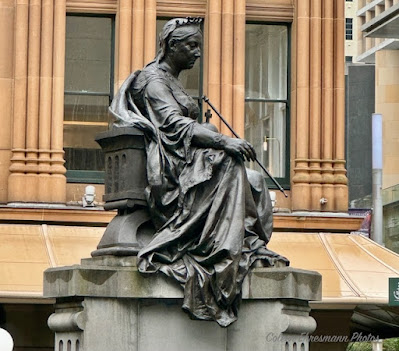Once again it was because of geocaching that we entered this beautiful landmark in Sydney. The Queen Victoria Building or QVB as it is known was near the train stop we used to get to Circular Quay and the Opera House and across the street from the first geocache we found in Sydney at Town Hall in the central business district or CBD.
The Romanesque Revival building built between 1893 and 1898 was designed by the architect, George McRae. Designed as a marketplace (building is 98'x620'), it covers a full city block.
OFD is standing in front of a fountain, listening to Islay.
During one of the redevelopment stages of the QVB an unsightly ventilation shaft was discovered and cleverly covered by a sandstone wishing well. Queen Victoria's favorite pet, a sky terrier by the name of Islay was used as the decoration. Islay is a talking dog that says, “Hello, my name is Islay. I was once the companion of the great Queen Victoria. Because of the many good deeds I have done for deaf and blind children, I have been given the power of speech. If you cast a coin into the wishing well now, I will say thank you… Thank you. Woof, woof.”
Islay was sculpted in 1987. The real Islay lived from 1839-1844 and is buried at Windsor Castle.
Queen Victoria was the ruler of The United Kingdom of Great Britain and Ireland from June 1839 to her death in 1901.
The building was named for Queen Victoria in commemoration of her Diamond Jubilee, marking 60 years of service and the first British monarch to reach that mark on June 20, 1897.
The dominant feature of the building is the central dome which consists of an interior glass dome and a copper-sheathed exterior, topped by a domed cupola. ~ Wikipedia
The rooftop includes other domes of various sizes.
The Royal Clock
The Royal Clock is located in the southern part of the QVB. The clock activates on the hour from 9 am until 9 pm. Each performance begins with the music of the trumpet voluntary as miniature trumpeters emerge from the tops of each of the clock's four outer turrets. The trumpeters withdraw at the end of the voluntary. The six scenes are viewed (one at a time) through windows on both sides of the clock that face the railed walkways. Each scene briefly illuminates to display a diorama of English royal history, before dimming and rotating to the left in preparation for the next scene. ~ Wikipedia
We were not there to hear an hourly chime.
Great Australian Clock
Located in the northern part of the QVB, this clock was our geocaching destination. Standing 133 feet tall and weighing 4 tons, the clock depicts the history of Australia. Both Aboriginal and European settlers are featured by the 138 figures in the some 33 scenes on the clock face. (I photographed 5 scenes, each of them must revolve and display even more scenes.)
The clock was installed in 2000. Designed by clockmaker Christopher Cook it took 4 years to build and cost $1.5 million. It is claimed to be the world's largest hanging animated turret clock.
(Captain Cook) Second Fleet Landing 1790
Crossing the Blue Mountains 1813
The Taking of the Children
Aborigines Before While Settlement
dome of The Great Australian Clock
this circular staircase in the corner caught my eye
leading to a door at the top on the third floor
leading to one of several turrets?
the stained glass window above street entrance
gold decor high on the walls
the interior colored glass inside the central dome
carpeted hallway, glass domed ceiling, hallways of shops
on the third floor
the center of the QVB is open from one end to the other
all 3 floors have shops along the sides
indicator for women's restroom
I was unable to find the signage for the men
OFD took photos of the opulent second floor women's restroom
shops in the QVB such as: jewelry, clothing, accessories,
sporting goods, stationary, cosmetics, shoes,
coffee shops, small cafes
The Queen Victoria Building underwent a major upgrade in 2009, welcoming new escalators connecting upper levels, elevators, painting throughout, balustrades, carpet, signage and bathrooms.
The QVB was built on the site of an 1810 market. In 1820 a two-story building was constructed on the site. The Druitt street end had offices to administer the market. The cross-shaped Greenway's Market House sold maize, wheat, green forage, vegetables, turkeys, ducks, geese, pigs, drapery and groceries. In 1959 after some years of low shop owner occupancy, a council member suggested the QVB be demolished. In 1971 the council committed to restoring the QVB but nothing happened until 1984 when restoration began, The QVC reopened to the public in 1986.























No comments:
Post a Comment
Thanks for your comments!